It’s now June and winter has arrived. Out on the water, it’s cold, wet and windy and all the snapper have exited Port Phillip…right? Wrong!
During the cooler months, a thriving population of juvenile snapper gather on the inshore reefs around the top end of Port Phillip. Most range in size from barely legal up to about 55cm or 2kg in weight, with the odd 5kg plus monster making an occasional appearance. Feeding heavily on mussels, scallops, marine worms and the abundant bait schools which also seek refuge across the inner reefs at this time of year, pinkie snapper certainly offer some entertaining action in the shallows.
I’m talking depths ranging from just 2-6m where those with smaller craft, including tinnies and kayaks, are in their element. Given the right conditions, many of the local piers and jetties provide excellent access for land-based anglers, while pockets of pinkie snapper are also available in the lower to middle reaches of both the Yarra and Maribyrnong Rivers.
While a large proportion of migrating snapper undoubtedly leave Port Phillip shortly after spawning, significant numbers remain in the bay year round. Many of the inshore reef systems spread throughout the northern section of the bay, from say Mordialloc around to Point Cook, are known to attract populations of pinkies, especially during the cooler months. Of particular note, the stretch along the front of the marine park from Ricketts Point down to Black Rock is a highly productive target area.
In addition to the reef, there is some excellent man-made structure in the form of mussel farms out from the Beaumaris Motor Yacht Squadron which is well worth a look. West of the Yarra River, the shallow reef extending from the Time Ball Tower on Battery Road out towards the Gellibrand Shoal marker and across to the Williamstown Football Ground pavilion is another hot spot. Both the inner and outer drift over the shallow reef in front of Altona Boat Ramp through to the pier can also be highly productive, especially of an evening.
Further around at Point Cook, the reef directly out from the old abandoned RAAF base jetty, back towards the marine park, rounds out a fairly long list of prominent inshore options. Of course, numerous smaller reef systems and patches of rubble interspersed with weed, sand and mud also exist in between these more significant locations.
A quality depth sounder and chart plotter is clearly a distinct advantage when prospecting new ground, but not always essential. It’s worth noting that the mobile berley trail created by marauding schools of Australian salmon attract all manner of opportunistic scavengers, including pinkie snapper. Provided you can get a soft plastic past the sambos, pinkie snapper are often found lurking below the commotion, mopping up pieces of flesh and guts as it falls through the water column. Any sign of birds diving at bait schools is worthy of investigation.
The trick is to hang out wider and cast behind all the surface activity where the bits of bashed up bait are still lingering.
Pinkie snapper have a tendency to venture into some sneaky locations, especially during and immediately following a strong on-shore blow from the southwest or whenever bait schools are present. If conditions are too rough on the open reefs for safe and comfortable boating, tucking in behind the protective rock groins at Sandringham, Brighton, St Kilda, Port Melbourne and Williamstown generally provides some shelter.
Similarly, many of the nearby piers and jetties provide a barrier from the wave action and fishing amongst the older wooden pylons can turn up some surprising catches. These structures also provide a stable platform for the army of local land-based bait anglers. Arguably the most consistent catches come from the main piers at Altona, Port Melbourne, St Kilda, Beaumaris and Mordialloc.
For those with pedal powered kayaks or boats equipped with a bow mounted electric motor, prospecting the swing mooring chains within Williamstown and St Kilda Marina is productive at times. Here, pinkie snapper can be found stacked up under the yacht hulls, but extracting them is often a real challenge.
Following bait well up into Melbourne’s metropolitan rivers during mid to late autumn, pinkie snapper remain a viable target through winter. The rock wall and fishing platforms dotted along the western shoreline, from the mouth of the Yarra River to the West Gate Bridge, are popular with land-based bait anglers. Similarly, the passenger ferry jetty just downstream of Pier 35 on the eastern bank also provides a shore-based option, while the area surrounding the base of the Bolte Bridge adjacent to North Wharf can be productive.
At times, pinkie snapper also show up in the calm waters of Victoria Harbour. Feeding aggressively in numbers when they first arrive, these fish gradually become more selective as they mix with bream and take up residence amongst the maze of pylons. Although it can get bitterly cold, fishing after dark is generally more productive. Larger pinkies, as well as some decent sized snapper mind you, are a reasonably common by-catch for those specifically targeting mulloway with live baits further up both rivers.
Fishing on the drift has become increasingly popular in recent times with many anglers doing away with static bait fishing techniques and instead opting for a more dynamic approach in the form of lightweight spin tackle and soft plastics. Prospecting the inshore reefs in this fashion allows you to quickly cover ground which means you should find the fish faster.
First and last light is most definitely the prime time in the shallows. Overcast or cloudy skies, combined with a moderate breeze and steady chop, help prolong this short bite window. Fishing through multiple tide changes also improves your chances of finding some action.
Most readers that follow my reports will be aware that I’m an avid fan of worm pattern soft plastics, especially those with wriggly tails, such as the Gulp Turtle Back variety. Others swear by baitfish imitations, but at the end of the day, pinkie snapper are competitive scavengers and not all that fussy.
Over the years, I’ve found most pinkies strike at a plastic as it falls through the water column after the initial cast. Some pick it up whilst it’s lying on the bottom and a fairly small percentage can be enticed to strike midway through the retrieve. From a beginner’s perspective, this must be encouraging!
Once you’ve rigged the plastic neatly on a suitable jig-head, make a long cast and you’re more than half way there. While it may take some practice to control the line, detect hits and set the hook, I’ve watched plenty of novices catch pinkies on plastics during their first attempt.
As the plastic descends, keep a close eye on the bow in the line between the rod tip and the point at which it enters the water. As soon as you notice the line flick, twitch or straighten, strike to jam the hook home, just as you would when bait fishing.
When feeding aggressively, pinkies often charge off with a plastic, pinning themselves in the process. If the plastic makes it to the bottom without being hit, the line will relax, at which point you can commence a basic lift and pause style retrieve. Maintaining contact with the jig-head helps to maximise the hang time and keeps the plastic hovering in front of the fish for longer. It also helps you to detect more subtle enquiries that quite often come from larger reds. Once you’ve brought the plastic about half way back to the boat, simply reload and go again.
Chasing pinkie snapper on plastics is not all that difficult provided you adhere to a few fundamental basics.
In summary, use good quality purpose built spin gear, rig the plastic straight, cast as long as possible, watch the line carefully to detect hits and fish the change of tide at first or last light. Whether you’re an avid lure caster or a more conventional bait angler, get out there this winter and nail a few pinkies on plastics.
By the time the snapper season rolls around again you’ll be all primed up and ready for action.
Facts
Suggested Tackle and Equipment
Rods and Reels
Attempting to cast lightly weighted soft plastics with traditional snapper outfits just doesn’t work and I suspect this is why some become frustrated and avoid the use of more modern techniques altogether. In order to maximise casting distance and bring the plastic to life underwater, a crisp graphite spinning rod up to about 7ft in length is the only way to go.
Recently, I’ve been trialling both the Vanguard (3-5kg) and Velocity (4-6kg) series spinning rods by Abu Garcia. Matched to Revo Premier and Inshore series threadline reels, these outfits do the job nicely. The lighter set up is spooled with 6lb Berkley Nanofil connected to a rod length of 8lb Trilene fluorocarbon leader. The heavier rig, which is most often used with larger profile plastics in the hope of tempting a big winter red, is spooled with 8lb mainline and 10lb leader material.
Soft Plastics and Jig-heads
Gulp Turtle Back Worms (Pumpkinseed, Watermelon and Camo)
Gulp Craws (Pumpkinseed and Camo)
Gulp Crazy Legs Jerkshads (New Penny and Watermelon)
Nitro Stealth Jig-heads (1/8 oz. #1 and 1/6oz #1/0)
Berkley Power Jig-heads (1/8 oz. #1/0)
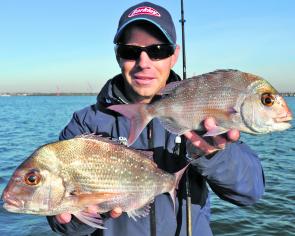
What the winter run of pinkie snapper may lack in size, they generally make up for in numbers.

The lower to middle reaches of both the Yarra and Maribyrnong Rivers are home to seasonal populations of pinkie snapper.

Worm pattern soft plastics, especially those with wriggly tails, such as the Gulp Turtle Back are highly effective.
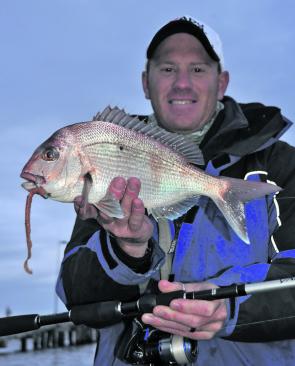
Pinkie snapper have a tendency to venture into some sneaky locations, many of which, including the base of jetties, rock walls and swing moorings, are located very close to shore.
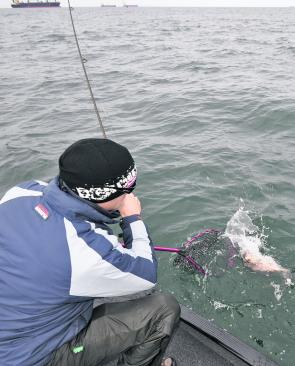
The combination overcast skies and relatively choppy conditions, coupled with a tide change, can trigger a feeding frenzy across the shallow reefs.
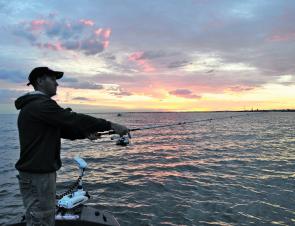
Fishing with soft plastics on the drift allows you to quickly cover ground which means you should find the fish faster. A long cast ahead of the boat is the way to go in the shallows.
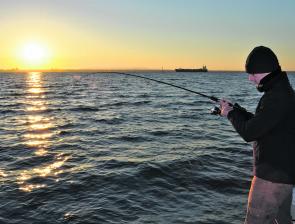
First and last light is most definitely the prime time for pinkies on the inner reefs, though fishing through tide changes also increases the likelihood of finding some action.
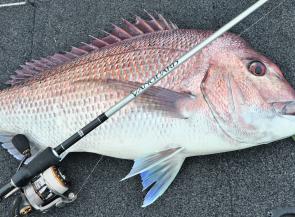
While most pinkies encountered on the shallow reefs during winter are relatively small, there’s always a chance a big bruiser will show up.




